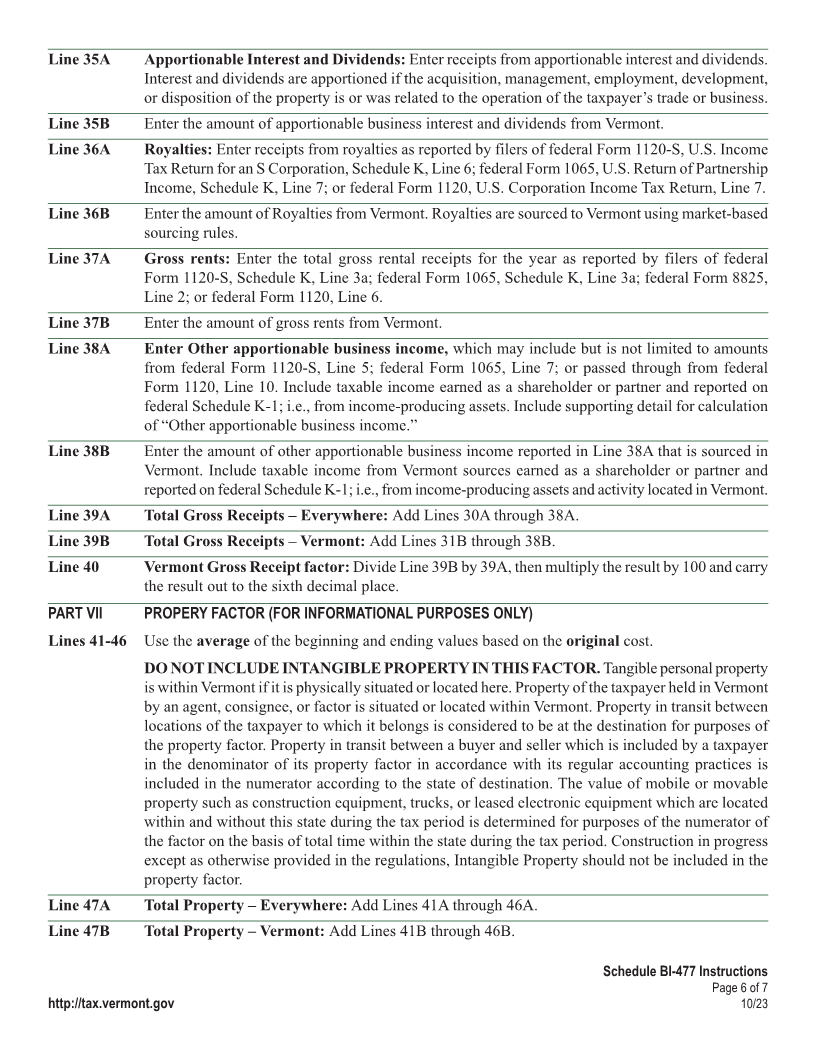
Enlarge image
SCHEDULE BI-477 Instructions
Vermont Income Adjustment Calculation: Pass-Through Nonresident
Page 1
General Information
Schedule BI-477 is new for 2023. It replaces Schedule BA-402, Vermont Apportionment & Allocation, for business
income tax filers. Schedule BA-402 is no longer filed with Form BI-471.
Schedule BI-477 improves the calculation of Vermont income and tax for most pass-through entities and their
owners. It mirrors the Vermont personal income tax statutes that dictate what is included in Vermont
income. It also draws information directly from federal Schedules K-1, which will improve ease of
administration, clarity, and accuracy.
Information from Schedule BI-477 (Line 27, 28, 29) will flow to Schedules BI-472, Vermont Non-Composite
and BI-473, Vermont Composite to calculate requirements for nonresident estimated payments and
composite tax, respectively.
While Schedule BI-477 is designed for pass-through businesses and generally applies the rules and methods for
sourcing income for nonresident individuals, it relies on principles of corporate apportionment for INSTR (Place at FIRST page)
Instr. pages
apportionable business income. Taxpayers will calculate a Sales & Receipts factor in Section 2,
Part VI, which will apply to Part IV, Business Income for businesses who operate in multiple states.
This will contribute to the calculation of the Income Adjustment in Part V, which is parallel to that
used for Vermont’s personal income tax.
Parts I – IV report items of taxable income listed in 32 V.S.A. § 5823(b), as earned Everywhere 1 - 7
and attributable to Vermont. (Ordinary business income in Part IV will use an apportionment
percentage calculated in Part VI if that income is derived from activity in Vermont and at least one
other jurisdiction.)
Part V determines the income adjustment, or portion of federal/everywhere income that is taxable
to Vermont - similar to the Vermont individual income tax return and Schedule IN-113.
Part VI calculates the apportionment of business income for entities that have ordinary business
income derived in Vermont and at least one other jurisdiction. This will be used in Part IV. This
calculation is identical to apportionment of income for corporate income tax. Effective Jan. 1, 2023,
Vermont uses the single sales factor method to calculate apportionment, replacing three factor
apportionment.
Part VII reports property factors which will be used by owners who are C-Corporations and are
required to include property factors from flow-through activity on the apportionment schedules
attached to their Vermont corporate income tax returns.
Schedule BI-477 is required for all Partnership, S Corporations, and LLC pass-through entities having activity
(income or loss) outside of Vermont. You do not have to complete this schedule if your business
activity is exclusively in Vermont. If a Schedule BI-477 is not attached to the return, apportionment
will be assumed to be 100%. If you are claiming the “No Vermont Activity” exception from the
minimum tax, then you must submit a Schedule BI-477 that accurately reports “Everywhere”
activity and no Vermont activity.
Schedule BI-477 Instructions
Page 1 of 7
http://tax.vermont.gov 10/23





